| Tank | ||||
|---|---|---|---|---|
 | ||||
| Studio album by | ||||
| Released | 28 February 2005 | |||
| Recorded | 2004–2005 | |||
| Genre | Electronica | |||
| Length | 53:40 | |||
| Label | EMI | |||
| Asian Dub Foundation chronology | ||||
| ||||
Tank is the fifth studio album by British alternative electronica band Asian Dub Foundation.
| Tank | ||||
|---|---|---|---|---|
 | ||||
| Studio album by | ||||
| Released | 28 February 2005 | |||
| Recorded | 2004–2005 | |||
| Genre | Electronica | |||
| Length | 53:40 | |||
| Label | EMI | |||
| Asian Dub Foundation chronology | ||||
| ||||
Tank is the fifth studio album by British alternative electronica band Asian Dub Foundation.
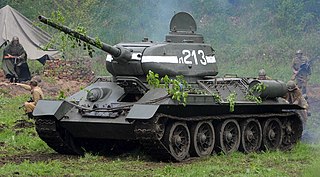
The T-34 is a Soviet medium tank from World War II. When introduced, its 76.2 mm (3 in) tank gun was more powerful than many of its contemporaries, and its 60-degree sloped armour provided good protection against anti-tank weapons. The T-34 had a profound effect on the conflict on the Eastern Front, and had a long-lasting impact on tank design. The tank was praised by multiple German generals when encountered during Operation Barbarossa, although its armour and armament were surpassed later in the war. Its main strength was its cost and production time, meaning that German panzer forces would often fight against Soviet tank forces several times their size. The T-34 is also a critical part of the mechanized divisions that form the backbone of the Deep Battle Strategy.

The 8.8 cm KwK 36 was an 88-millimetre (3.5 in) tank gun used by the German Army during World War II. This was the primary armament of the PzKpfw VI Tiger I tank. It was developed and built by Krupp.

The Kliment Voroshilov (KV) tanks are a series of Soviet heavy tanks named after the Soviet defence commissar and politician Kliment Voroshilov who operated with the Red Army during World War II. The KV tanks were known for their heavy armour protection during the early stages of the war, especially during the first year of the German invasion of the Soviet Union. In certain situations, even a single KV-1 or KV-2 supported by infantry could halt German formations. The German Wehrmacht at that time rarely deployed its tanks against KVs, as their own armament was too poor to deal with the "Russischer Koloss" – "Russian Colossus".

The Panzer II is the common name used for a family of German tanks used in World War II. The official German designation was Panzerkampfwagen II.
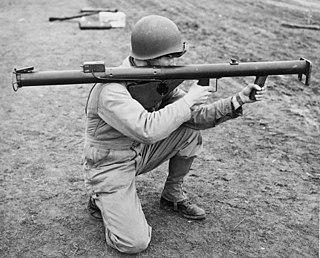
A bazooka is a man-portable recoilless anti-tank rocket launcher weapon, widely deployed by the United States Army, especially during World War II. Also referred to as the "stovepipe", the innovative bazooka was among the first generation of rocket-propelled anti-tank weapons used in infantry combat. Featuring a solid-propellant rocket for propulsion, it allowed for high-explosive anti-tank (HEAT) shaped charge warheads to be delivered against armored vehicles, machine gun nests, and fortified bunkers at ranges beyond that of a standard thrown grenade or mine. The universally applied nickname arose from the M1 variant's vague resemblance to the musical instrument called a bazooka invented and popularized by 1930s American comedian Bob Burns.

The Panzerkampfwagen III, commonly known as the Panzer III, was a medium tank developed in the 1930s by Germany, and was used extensively in World War II. The official German ordnance designation was Sd.Kfz. 141. It was intended to fight other armoured fighting vehicles and serve alongside and support the similar Panzer IV, which was originally designed for infantry support.

Panzerkampfwagen VIII Maus was a German World War II super-heavy tank completed in July of 1944. It is the heaviest fully enclosed armored fighting vehicle ever built. Five were ordered, but only two hulls and one turret were completed, the turret being attached before the testing grounds were captured by advancing Soviet military forces.

The 8.8 cm Flak 18/36/37/41 is a German 88 mm anti-aircraft and anti-tank artillery gun, developed in the 1930s. It was widely used by Germany throughout World War II and is one of the most recognized German weapons of the conflict. The gun was universally known as the Acht-acht ("eight-eight") by the Germans and the "eighty-eight" by the Allies. Due to its lethality, especially as a tank killer, the eighty-eight was greatly feared by Allied soldiers.

The Leopard 2 is a third generation German main battle tank (MBT). Developed by Krauss-Maffei in the 1970s, the tank entered service in 1979 and replaced the earlier Leopard 1 as the main battle tank of the West German army. Various iterations of the Leopard 2 continue to be operated by the armed forces of Germany, as well as 13 other European countries, and several non-European countries, including Canada, Chile, Indonesia, and Singapore. Some operating countries have licensed the Leopard 2 design for local production and domestic development.
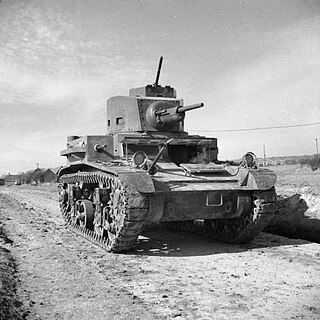
The M2 light tank, officially Light Tank, M2, was an American light tank of the interwar period which saw limited service during World War II. The most common model, the M2A4, was equipped with one 37 mm (1.5 in) M5 gun and five .30 cal M1919 Browning machine guns.

The Pak 36 is a 3.7 cm / 37mm caliber German anti-tank gun used during the Second World War. It was the main anti-tank weapon of Wehrmacht Panzerjäger units until 1942. Developed by Rheinmetall in 1933, it was first issued to the German Army in 1936, with 9,120 being available by the beginning of the war in September 1939 and a further 5,339 produced during the war. As the predominant anti-tank gun design in the world during the late 1930s, demand was high for the Pak 36, with another 6,000 examples produced for export and the design being copied by the Soviet Union as the 45 mm anti-tank gun M1932 (19-K) and by other nations such as Japan.
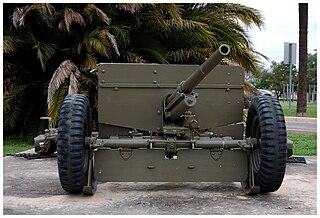
The 37 mm gun M3 is the first dedicated anti-tank gun fielded by United States forces in numbers. Introduced in 1940, it became the standard anti-tank gun of the U.S. infantry with its size enabling it to be pulled by a jeep. However, the continuing improvement of German tanks quickly rendered the 37 mm ineffective and, by 1943, it was being gradually replaced in the European and Mediterranean theaters by the more powerful British-developed 57 mm gun M1. In the Pacific, where the Japanese tank threat was less significant, the M3 remained in service until the end of the war, but some 57mm guns were issued.

The SO-152, usually known by its GRAU designation 2S3, is a Soviet 152.4 mm self-propelled gun developed in 1968, as a response to the American 155 mm M109 howitzer. Development began in 1967, according to the Resolution of the Council of Ministers of the Soviet Union from July 4, 1967. In 1968, the SO-152 was completed and in 1971 entered service. The fighting vehicle also received the added designation Akatsiya (Акация), which is Russian for Acacia.
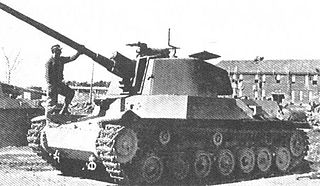
The Type 4 medium tank Chi-To was one of several medium tanks developed by the Imperial Japanese Army towards the end of World War II. While by far the most advanced Japanese wartime tank to reach production, industrial and material shortages resulted in only a few chassis being manufactured and only two known to be completed. Neither of the completed Type 4 Chi-To tanks saw combat use.

The 7.62 cm FK 36(r) and Pak 36(r) were German anti-tank guns used by the Wehrmacht in World War II. The first guns were conversions of the Soviet 76 mm divisional gun M1936 (F-22). Later in the war, the Soviet USV and ZiS-3 76 mm divisional guns were also converted.

A main battle tank (MBT), also known as a battle tank or universal tank, is a tank that fills the role of armour-protected direct fire and maneuver in many modern armies. Cold War-era development of more powerful engines, better suspension systems and lighter composite armour allowed for the design of a tank that had the firepower of a super-heavy tank, the armour protection of a heavy tank, and the mobility of a light tank, in a package with the weight of a medium tank. The first designated MBT was the British Chieftain tank, which during its development in the 1950s was re-designed as an MBT. Throughout the 1960s and 1970s, the MBT replaced almost all other types of tanks, leaving only some specialist roles to be filled by lighter designs or other types of armoured fighting vehicles.
The 9th Bobruisk-Berlin Red Banner Order of Suvorov Tank Division was the designation of two separate formations of the Soviet Army. The original 9th Tank Division was formed in 1940 and later reorganized into a different division. During World War II, the Soviet Army formed the 9th Tank Corps, which was renamed the 9th Tank Division after the defeat of Germany in 1945. This second instance of the 9th Tank Division served with the Group of Soviet Forces in Germany from 1945 until about 1991, when it was disbanded.

The Tiger I was a German heavy tank of World War II that began operational duty in 1942 in Africa and in the Soviet Union, usually in independent heavy tank battalions. It gave the German Army its first armoured fighting vehicle that mounted the 8.8 cm KwK 36 gun. 1,347 were built between August 1942 and August 1944. After August 1944, production of the Tiger I was phased out in favour of the Tiger II.
The siege of Rastan and Talbiseh was an operation by the Syrian Army during the Syrian revolution. On 28 May 2011, after protests and an armed revolt, the Syrian Army launched an operation in al-Rastan, a city of an estimated 50,000 residents located 20 kilometers north of Homs, and the neighboring town of Talbiseh, which resulted in the suppression of the protests and numerous deaths. The Syrian Army met some armed opposition during the siege.